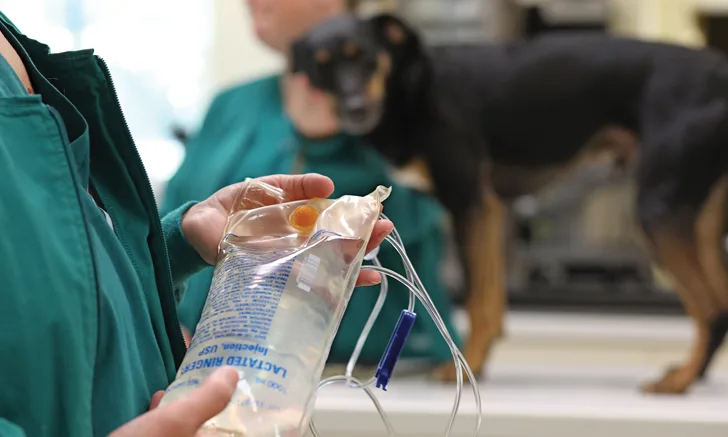Acute Hemorrhagic Diarrhea Syndrome
Amanda A. Cavanagh, DVM, DACVECC, Colorado State University

Acute hemorrhagic diarrhea syndrome (AHDS), formerly termed hemorrhagic gastroenteritis (HGE), is an acute condition of unknown cause characterized by severe hemorrhagic diarrhea and vomiting. AHDS typically affects young to middle-age, small-breed dogs1 and can lead to cardiovascular collapse and death without early aggressive therapy. Recovery is often rapid and complete with appropriate symptomatic treatment.
Endoscopic evaluation of affected dogs reveals no macroscopic or histologic gastric pathology, despite a high incidence of vomiting and hematemesis in many patients.1,2 Severe, coagulative necrosis of the small and large intestines2 is present histologically, however, and HGE was renamed AHDS following these findings.2
Clinical Signs
AHDS is characterized by peracute onset of vomiting, followed by lethargy, anorexia, hematemesis, and large volumes of malodorous hemorrhagic diarrhea.1 In a prospective study of 108 dogs with AHDS, diarrhea occurred a median of 10.5 hours after the onset of vomiting.1
Dogs with AHDS have severe mucosal necrosis and minor neutrophilic infiltrate of the small and large intestines, resulting in secretory and malabsorptive diarrhea.2 Transudation of water, electrolytes, and protein, and disrupted sodium transport mechanisms leads to significant fluid loss.3 Subsequent hypovolemia and dehydration occur early during the disease.
Hypovolemia results in tachycardia, peripheral vasoconstriction (ie, pale mucous membranes, delayed capillary refill times, cool distal extremities), low rectal temperature, depressed mentation, and diffuse muscle weakness.1
AHDS Key Points
Without rapid appropriate therapy, an AHDS patient’s clinical signs can quickly progress to hypovolemic shock, multiple organ dysfunction, disseminated intravascular coagulation, and death.
With early and aggressive inhospital care, patients typically recover rapidly (ie, within 24 to 48 hours) without lasting adverse effects.1,7
Despite possible associated pathogens, AHDS has not been demonstrated to be zoonotic or transmissible to other animals.
Diagnosis
AHDS is a diagnosis of exclusion. Other causes of acute hemorrhagic diarrhea and vomiting, including parvoviral enteritis, intestinal parasites (eg, whipworms, Trichuris vulpis), salmonellosis, intestinal obstruction, intussusception, toxicosis, coagulopathies, pancreatitis, hypoadrenocorticism, and systemic disease, must first be ruled out. A diagnostic evaluation should include a thorough history, physical examination, CBC, serum chemistry profile, urinalysis, coagulation testing, fecal flotation examination, and diagnostic imaging. In addition to hemoconcentration, CBC may reveal an inflammatory leukogram with a normal platelet count. Serum chemistry may reveal electrolyte disturbances and prerenal azotemia if dehydration is severe or prolonged. Abdominal radiographs often show diffuse gas-filled small and large intestinal loops and should be used to rule out gastrointestinal obstruction.
Marked hemoconcentration typically is present in AHDS patients, with packed cell volumes (PCV) approaching 60% to 80% secondary to hypotonic losses into the gastrointestinal tract. Although diarrhea is often described as raspberry jelly-like in consistency and color, intestinal losses are primarily water with only small concentrations of RBCs.1
A prospective evaluation of AHDS dogs identified no specific hematocrit cut-off value to definitively diagnose AHDS.1 Total protein concentration does not increase similarly to hematocrit in these patients because intestinal protein loss causes normal-to-low total protein concentration.
Causes
The exact cause of AHDS remains unknown. Possible etiologies include infection with enterotoxigenic bacterial strains, the release of bacterial endotoxins, an abnormal immune response to intestinal bacteria, intestinal Type I hypersensitivity reactions to dietary components or bacterial endotoxins, and enteric viruses.
Some studies suggest that clostridial infection is associated with, but may not be the sole cause of, ADHS,2,4-6 and intestinal dysbiosis may be present during the course of disease.7 A 2012 paper theorized that increased virulence of some strains of C perfringens, which is caused by gene mutation or plasmid acquisition-encoding enterotoxins, could result in AHDS.8
Treatment
Marked fluid loss can cause acute decompensation and rapid progression to death without early, aggressive IV administration of balanced crystalloid fluids (eg, lactated Ringer’s solution). Crystalloid fluid boluses of 10 to 20 mL/kg are rapidly infused while changes in heart rate, mucous membrane color, capillary refill time, distal extremity temperature, and mentation are monitored. In patients with marked hypoproteinemia, fluid resuscitation may also require synthetic colloids. Fluid resuscitation continues until perfusion parameters normalize.
Continued fluid therapy is aimed at correcting dehydration, replacing ongoing losses from vomiting and diarrhea, and providing daily maintenance water needs. Serial body weight monitoring is helpful for determining fluid balance in these patients because gastrointestinal losses are difficult to estimate. With resuscitation and rehydration, the PCV should normalize, although protein concentrations remain low secondary to gastrointestinal losses.
Evidence suggests that dogs with AHDS do not typically experience bacteremia secondary to bacterial translocation, despite a loss of intestinal mucosal barrier integrity.9 A prospective evaluation of dogs with AHDS showed no difference in disease severity, laboratory parameters, hospitalization time, or outcome between dogs with negative bacterial blood cultures and the small percentage of patients with positive bacterial blood cultures.9 In dogs with AHDS, intestinal bacteria that enter the portal bloodstream can likely be cleared effectively, preventing septicemia because the immune system remains normal.
Another prospective study of dogs with AHDS compared those who received amoxicillin/clavulanic acid with those who received placebo treatment and found no difference in severity of clinical signs, hospitalization time, or mortality between groups.6 These results suggest that antibiotic therapy is not necessary for most patients. However, leukopenic, hypotensive, and hemodynamically unstable patients should receive appropriate antimicrobial treatment.
Parenteral antiemetic therapy (eg, maropitant,10 ondansetron11) is warranted to control vomiting. The median hospitalization time in a retrospective study was 3 days.1
Conclusion
AHDS is a severe but easily treatable condition when diagnosed and treated early in the course of the disease. Because early recognition is key and AHDS is a diagnosis of exclusion, practice team members need to be fully aware of the symptoms and other likely differential diagnoses with similar clinical presentations. (See AHDS Key Points, above.)
This article originally appeared in the August 2018 issue of Veterinary Team Brief.